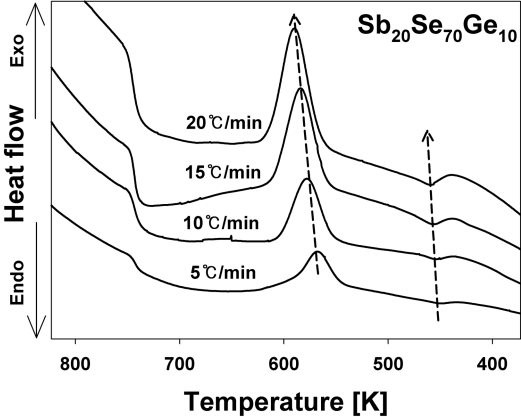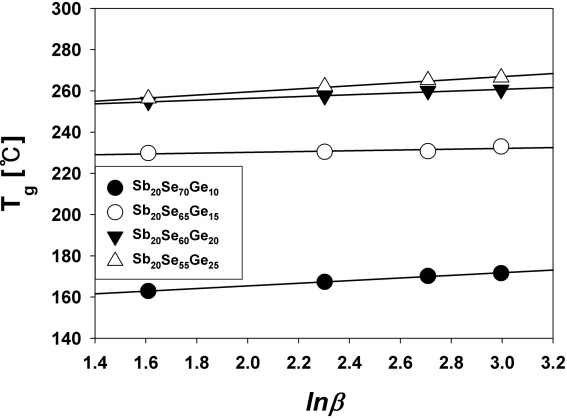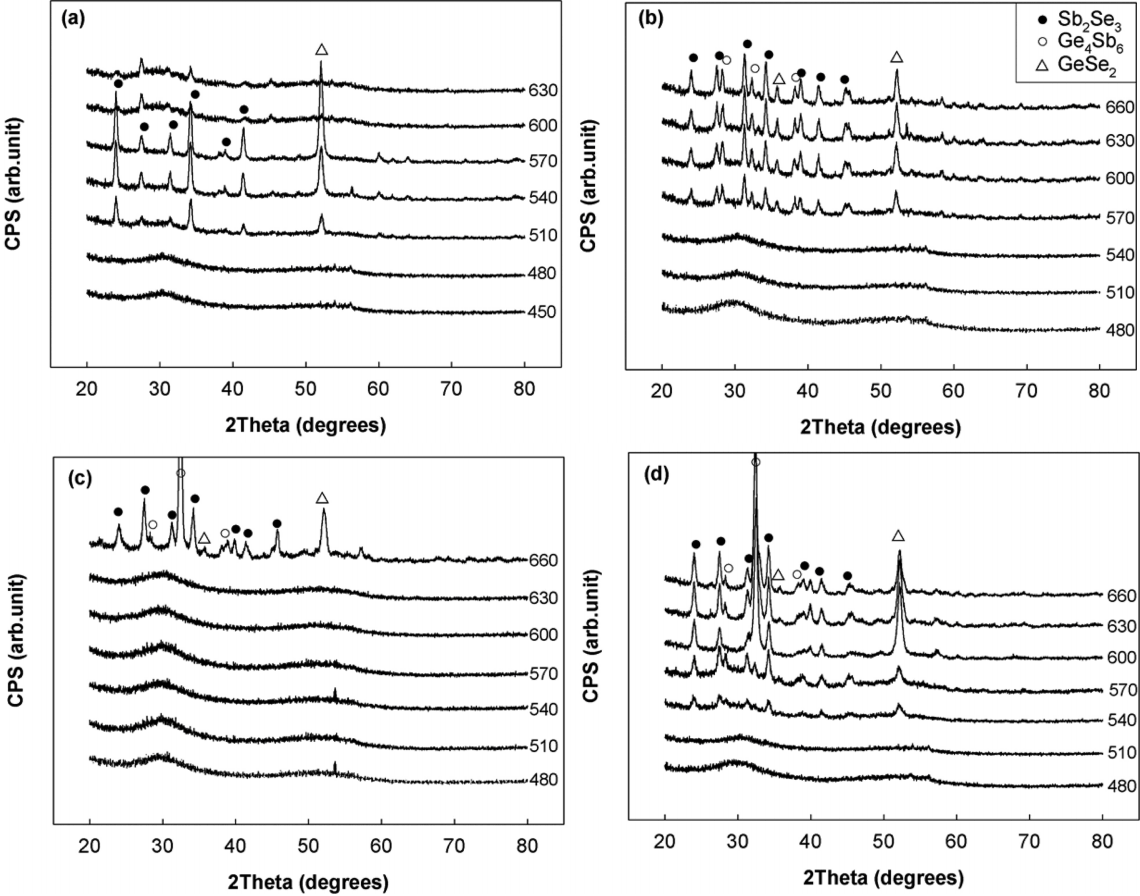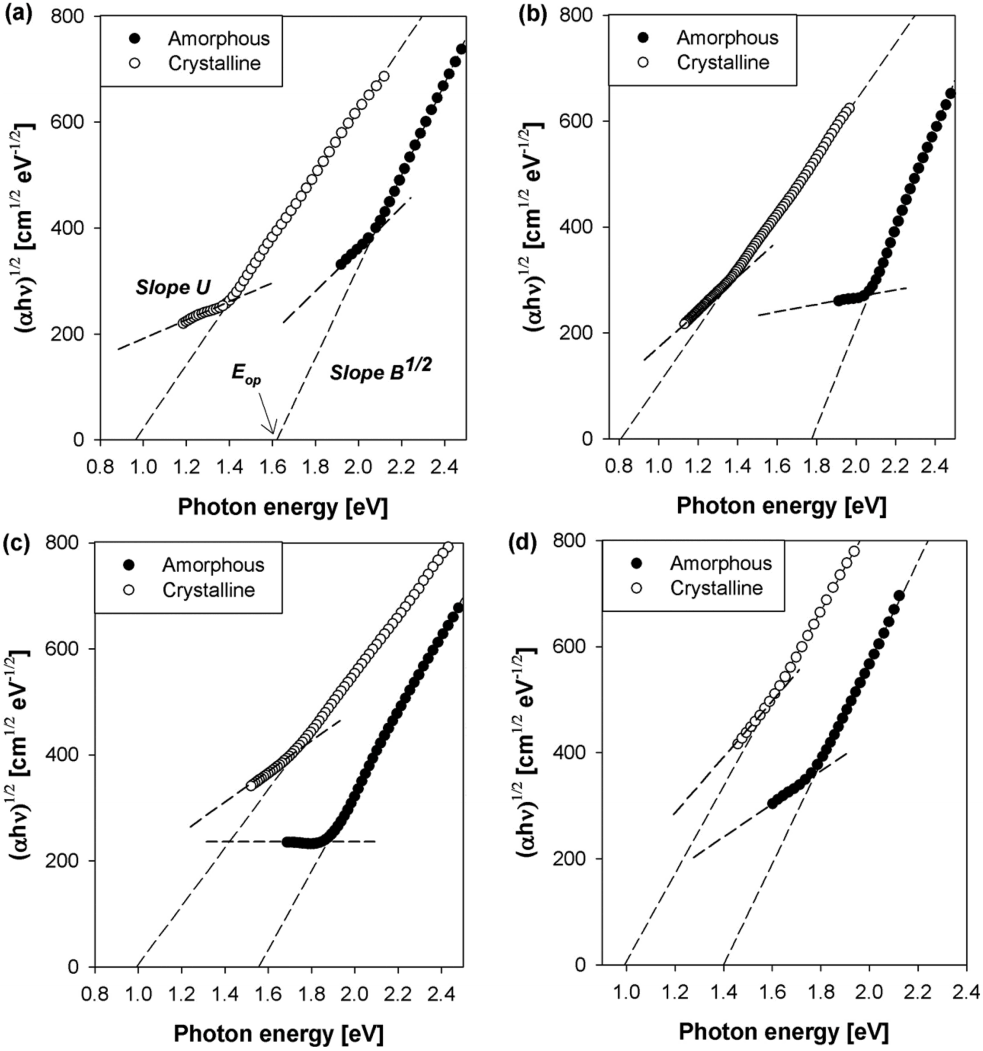Evaluations of Sb20Se80-xGex (x = 10, 15, 20, and 25) Glass Stability from Thermal, Structural and Optical Properties for IR Lens Application
Article information
Abstract
Chalcogenide glasses have been investigated in their thermodynamic, structural, and optical properties for application in various opto-electronic devices. In this study, the Sb20Se80-xGex with x = 10, 15, 20, and 25 were selected to investigate the glass stability according to germanium ratios. The thermal, structural, and optical properties of these glasses were measured by differential scanning calorimetry (DSC), X-ray diffraction (XRD), and UV-Vis-IR Spectrophotometry, respectively. The DSC results revealed that Ge20Sb20Se60 composition showing the best glass stability theoretically results due to a lower glass transition activation energy of 230 kJ/mol and higher crystallization activation energy of 260 kJ/mol. The structural and optical analyses of annealed thin films were carried out. The XRD analysis reveals obvious results associated with glass stabilities. The values of slope U, derived from optical analysis, offered information on the atomic and electronic configuration in Urbach tails, associated with the glass stability.
1. Introduction
Chalcogenide glasses are interesting inorganic materials owing to their superior optical transmittance and nonlinear refractive index in the infrared region. They can be used in IR optical devices such as IR lenses, fiber optics, and IR detectors owing to the optical properties.1–4) They have low cost, balanced optical and mechanical properties, and ease of molding process owing to their glass transition properties.5–7) To optimize the chalcogenide glass molding process and the reliability about amorphous to crystalline phase transition system, the glass stability in chalcogenide glasses is required owing to the stable amorphous state at the process temperature.
In infrared optics applications, Ge-Sb-Se system chalcogenides are used due to their suitable IR region transmittance, glass stability, mechanical properties, and chemical properties.8–12) In the Ge-Sb-Se system, we focused that the addition of germanium (Ge) is contributed to glass stabilities due to the resistance to strong tendency for crystallization according to the Sb-Se bonds, which are one of the core parts about glass properties.11) Therefore, the investigation of glass stability in the wide range of Ge rate is important to optimize the chalcogenide composition for amorphous IR optic applications.
In this study, we investigated the composition for the best glass stability in Sb20Se80-xGex chalcogenide systems by using the thermal, structural, and optical properties. The thermal properties of Sb20Se80-xGex (x = 10, 15, 20, and 25) were investigated by differential scanning calorimetry (DSC, Mattler Toledo DSC823e) analysis under non-isothermal conditions. DSC results were applied by theoretical models (Augis-Bennett, and Kissinger models) to calculate the phase transition activation energy for glass stability. The amorphous to crystalline structural properties and optical properties were studied in X-ray diffractometry (XRD, X’pert PRO Multi Propose X-ray diffractometer) and UV-Vis-NIR Spectrophotometry, respectively.
2. Experimental Procedure
Sb20Se80-xGex chalcogenide bulk glasses, where x = 10, 15, 20 and 25, were fabricated by the well-known melt-quenching method. High purity (99.999%) constituent elements of Ge, Sb, and Se were weighted according to proper atomic weight and then put into a cleaned quartz ampoule. The quartz ampoule for the melt-quenching technique was made of SiO2 and cleaned successively using nitric acid, sulfuric acid, and iso-propyl alcohol. The element-inserted quartz tubes were vacuum-sealed under 10−4 Torr by oxygen welding to prevent oxidation. The sealed ampoules were heated in a tube furnace at 498, 698, 963, and 1233 K for 2 h in consideration of the melting points and the boiling points of each element. Subsequently they were placed at 1273 K for 16 h because of the uniformity of composition. During the melting process, the quartz ampoules were stirred constantly to homogenize the constituents. The samples were quenched in cold water to get a glassy state.
Thin films were deposited by thermal evaporation from the open boat at a deposition rate of ~ 3 Å/s onto chemically cleaned p-type Si (100) and quartz substrates under a vacuum of 3 × 10−5 Torr, and the thickness ratio was measured using a quartz crystal sensor. The film thickness was fixed at ~ 200 nm. The deposited thin films were isothermally annealed at temperatures from 450 K to 630 K with 30 K intervals. The annealing process was performed under a flow of 200 sccm N2 gas for 30 min at a heating rate of 5 K/min to prevent the oxidation of the thin films.
The thermal properties of bulk samples were studied using the DSC method. The DSC curves were taken under non-isothermal conditions at different heating rates (5, 10, 15, and 20 K/min) on accurately weighted samples sealed in aluminum pans. Each scan was recorded from room temperature to 823 K. The calorimeter was calibrated using the well-known melting temperatures and melting enthalpies of zinc, indium, and gallium (20 mg), crimped into aluminum pans and scanned. To identify the amorphous-to-crystalline phase transition of the annealed Sb20Se80-xGex films, the annealed films were recorded by using XRD with Cu Kα radiation (λ = 1.542 Å).
The optical properties were measured using a UV-VIS-NIR spectrophotometer in the wavelength range ~ 300–1,100 nm. The optical transmittance of the amorphous and crystalline-annealed Sb20Se80-xGex thin films was recorded at room temperature. The absorption coefficient (α) for calculating optical bandgap was measured using the beer-lambert relation as α = −(1/d)ln(T), where d is the film thickness and T is transmittance of the film.
3. Results and Discussion
Figure 1 shows the DSC curves of Sb20Se80-xGex glasses (x = 10, 15, 20 and 25) at a heating rate of 5 K/min and Fig. 2 is the DSC curves corresponding to heating rate dependences of Sb20Se70 Ge10 chalcogenide glass. The DSC curves indicate a single glass transition endothermic slope and one or more crystallization exothermic peaks. The single endothermic glass transition confirmed the homogeneity. Fig. 1 shows that the glass transition temperature increased with increasing Ge ratio. The crystallization temperatures increased until the Ge ratio was 20%, and then the value according to 25% of Ge ratio decreased.

DSC graphs of the Sb20Se80-xGex (x = 10, 15, 20, and 25) glasses under non-isothermal condition at 5 K/min heating rate. Points of Glass transition (●) and crystallization peak (○) are revealed well in the DSC graph.

DSC graphs of the Sb20Se70Ge10 chalcogenide glasses at different heating rates of 5, 10, 15, and 20 K/min. The glass transition and crystallization temperatures gradually increased as increasing the heating rates, indicated by dash-line arrows.
The DSC graph parameters of the glass transition temperature (Tg), glass transition endothermic peak temperature (Tgp), onset crystallization temperature (Tc), peak crystallization temperature (Tp), and the temperature interval between peak crystallization and glass transition (Tp–Tg) are listed in Table 1.
As shown in the Fig. 2 and Table 1, the temperatures Tg and Tc increased gradually as the heating rate (β) increased. This phenomenon according to the Tg is explained using the empirical equation shown in Eq. (1), suggested by Lassocka et al.13)
Where A consists of Tg at a heating rate of 1 K/min, and B is the cooling rate which is taken by the system to reduce the glass transition temperature when the heating rate decreased from 10 K/min to 1 K/min. The plots of Tg versus ln β exhibited a linear relationship, as shown in Fig. 3. The values of A and B are listed in Table 2.

Glass transition temperature Tg relationship according to the heating rate, lnβ. These linear relationships mean an empirical Lassocka equation.
What is the glass transition is one of the issues in the noncrystalline solids. Some authors have given the glass transition as the glass-to-amorphous transition.14,15) The chalcogenide glass can, therefore, be divide in ‘glass’ phase and ‘amorphous’ phase around the point of Tg according to the non-crystal solids. The glass transition region consists of various metastable states separated by energy barriers. The atoms restricted in the metastable states tend to attain more stable states than others by overcoming this energy barrier.16) This energy barrier is known as the activation energy of the glass transition. The lower activation energy of glass transition has a higher probability to jump to the metastable state by the lower energy, which is the most stable state.17)
The activation energy of glass transition has been evaluated using the Kissinger equation, which is used for the crystallization region. It has also been frequently used for the evaluation of the activation energy of the glass transition.18,19)
The Kissinger equation optimized for the glass transition is shown by Eq. (2).
where Tgp is the endothermic peak temperature of the glass transition region and R is the universal gas constant. The plots of ln[β/ ] versus 1000/Tgp are shown in Fig. 4. The activation energy of glass transition (Eg) has been determined from the slope of the plot. The values of Eg according to the various compositions of glasses are listed in Table 3.

The Values of Glass Transition, Crystallization Energy, and Frequency Factor using Various Theoretical Models
The kinetics of the crystallization process under non-isothermal condition has been analyzed in terms of composition dependence of Tc, Tp, and an activation energy of crystallization (Ec). This activation energy considered as the energy according to amorphous to crystalline transformation is the whole process activation energies of the nucleation and the crystal growth.7) The values of Ec has been evaluated by two different methods under non-isothermal conditions.
First method is the Kissinger equation.20,21) The values of Ec can be obtained from the dependence of Tp on different heating rates, using Eq. (3) of the Kissinger model. The plots of ln[β/Tp2] versus 1000/Tp are shown in Fig. 5(a) for different glass compositions. The values of Ec can be calculated from the slope of the plots (straight lines)

Plots of (a) ln [β/Tp2] versus 1000/Tp corresponding to the Kissinger model and (b) ln [β/(Tp–T0)] versus 1000/Tp about the Augis-Bennett model.
The Augis-Benett model was used as another approach with an approximation method to calculate the value of Ec, and the formula of Augis-Benett model is given as Eq. (4).20,22–24)
Figure 5(b) shows the plots of ln[β/(Tp–T0)] versus 1000/Tp. The slope of straight line gives the Ec. This method has the advantages that the y-intercept of the plot gives the value of the frequency factor (K0) of the Arrhenius equation.20,24) The values of Ec and K0 obtained by two method are listed in Table 3.
As shown in Table 3, the tendencies of the Eg values are divided in two categories: ~ 230 kJ/mol at x = 10 and x = 20 compositions and ~ 300 kJ/mol according to x = 15 and x = 25. The Eg is involved in the molecular motions rearrangements of atoms. It is suggested that a minimum value of Eg has the higher probability to jump to the metastable state of lower configuration energy.25) In the suggestion, the higher glass forming stability depends on the lower value of Eg. As a result, the compositions of x = 10 and x = 20 have good glass forming ability compared to the composition of x = 15 and x = 25.
The values of Ec are also listed in Table 3. It is well known that the Tc and Ec are important parameters for the characteristics of the thermal stability of amorphous state, and they are considered to be related to the glass forming ability. It is clear from Table 3 that the Ec value increases with increasing Ge content. Especially the value of Ec is rising up from 172 kJ /mol to 260 kJ/mol as the changes of the composition from x = 15 to x = 20. The higher value of Ec has the advantage of anti-crystallization in the range of crystallization-danger intervals, which is an area between Tg and Tc. Once the temperature increase over the Tg, the nucleation occurs in a random fashion at various sites in the samples. After the nuclei grow up to the extent of critical size, the crystal growth is beginning.26) The higher value of Ec can kinetically impedes the process of nucleation and crystal growth at the crystallization-danger intervals. At the same times, the rate of crystallization is faster, because of decreased temperature range according to the nucleation and growth steps.22,25) Hence, it is obvious that the chalcogenide glasses with to x = 20 have excellent glass stability in the range between Tg and Tc compared to the x = 15.
Figure 6 shows the XRD patterns of the 30 min-annealed Sb20Se80-xGex chalcogenide thin films. The patterns are arranged by the annealing temperatures. Figs. 6(a) to (d) are corresponding to the compositions of Sb20Se80-xGex chalcogenide thin films from x = 10 to x = 25, respectively. As shown in Fig. 6, crystalline phase peaks appeared at the specific annealing temperatures, and the peaks are formed with increasing temperature. The crystalline phases consist of Sb2Se3, GeSe2, and Ge4Sb6.27,28) Fig. 6(a) onlyshows the Sb2Se3 and GeSe2 crystalline phase peaks because of the relatively lower Ge contents. In the Ge-Sb-Se chalcogenide system, it is suggested that the elements of the system prefer heteropolar bonds compared to homopolar bond. Furthermore, the heteropolar bonds are preferred to Sb2Se3, GeSe2, and Ge4Sb6, in order. Therefore, with increasing Ge contents, the crystalline peaks according to GeSe2 and Ge4Sb6 appear and increase in intensity. Comparing the composition of Sb20Se65Ge15 with Sb20Se60Ge20, the crystallization temperatures according to the compositions do not have much difference in the DSC result as shown in Fig. 1 and Table 3. However, as shown in Figs. 6(b) and (c), the temperatures of crystallization have the obvious temperature gap. This phenomenon considers that the composition of Sb20Se65Ge15 glasses has lower glass forming ability and glass stability than the composition of Sb20Se60Ge20 glasses, suggested by the result of thermal analysis.

XRD graphs according to Sb20Se80-xGex thin films. Figs. 6(a) to (d) correspond to compositions from x = 10 to x = 25, respectively, at different annealing temperatures from 480 K to 660 K excepting Sb20Se70Ge10. According to Sb20Se70Ge10 thin films, the surface of the thin films started to melt and destroyed from 600 K. For the reason, the annealing temperatures are lower than the others.
Amorphous chalcogenides with a strong electron-lattice interaction obey the absorption properties expressed as αhν = B(hν – Eop)n for the extended energy region (hν > Eop) and lies in the range ~ 103 cm−1/2 eV−1/2.29–32) B and Eop mean the slope of extended region and optical bandgap, respectively. Moreover, the U represents the slope of the Urbach tail region (hν < Eop).33) The exponent n is an appropriate and selected index, depending on the nature of electronic transition and can be assumed to have a value of either 1/2 or 2 for the direct and indirect transition, respectively.34) Many studies have shown n = 2 acceptable for amorphous chalcogenides, including GeSe, GeSbTe and GeSbSe.27,35–37)
Therefore, Eop is obtained from the intercept on the energy axis of the plot (αhν)1/2 versus hν as shown in Fig. 7. Figs. 7 (a), (b), (c), and (d) correspond to the composition of the Sb20Se70Ge10, Sb20Se65Ge15, Sb20Se60Ge20 and Sb20Se55Ge25, respectively. The quantities of Eop, B1/2 and U for the amorphous and crystalline-onset Sb20Se80-xGex were determined from Fig. 7 and are summarized in Table 4. The annealing temperatures according to crystalline-onset were applied from the XRD data.

plot (αhν)1/2 versus hν. (a), (b), (c) and (d) are corresponding to the composition of the Sb20Se70Ge10, Sb20Se65Ge15, Sb20Se60Ge20 and Sb20Se55Ge25, respectively. The quantities of B1/2 and U according to the amorphous and crystalline-onset Sb20Se80-xGex were determined by slope of the graph
As shown in Fig. 7 and Table 4, The Eop quantities of Sb20Se80-xGex (x = 10, 15, 20, and 25) amorphous films were ~ 1.62, 1.77, 1.55, and 1.39 eV, respectively. The Sb20Se65Ge15 composition exhibits the largest value of Eop, suggesting that the Sb20Se65Ge15 approaches the stoichiometric compositions in the Sb20Se80-xGex systems.38) In the stoichiometric composition, the heteropolar bands are larger than the homopolar bands, leading the average bond energy to the maximum state.27) After crystallization, the whole values of Eop decrease rapidly in the range ~ 0.8 – 1 eV. Two slopes B1/2 and U offer information on the atomic and electronic configuration in the extended and Urbach region, respectively. A slope reduction has been reported because of increasing of randomness in the atomic configuration.39) The values of U are listed in Table 4 and shown in Fig. 7. The lower value of U in the amorphous state means the superior heat confinement due to the large band-tail state.32) It may be regarded as the glass stability. The higher heat confinement means the acceptance of higher temperature, maintaining the glassy state. The Sb20Se65Ge15 and Sb20Se60Ge20 have sufficiently lower U values of 68 and 8 cm−1/2 eV−1/2, respectively, compared to the others with ~ 300 cm−1/2 eV−1/2. At the same times, they have a higher crystallization temperature than the others as shown by the result of thermal analysis. Sb20Se60Ge20 composition has the lowest U of 8 cm−1/2 eV−1/2 as compared to Sb20Se65Ge15. Hence, it is possible to accept more heat energy then the other compositions. Therefore, Sb20Se60Ge20 composition has the best glass stability.
4. Conclusions
The glass stability of Sb20Se80-xGex (x = 5, 10, 15, and 20) was investigated by thermal, structural, and optical analyses. The DSC curves of Sb20Se60Ge20 showed the highest crystallization temperature. The kinetics according to the glass transition and crystallization was investigated by the Kissinger and Augis-bennett models. These models exhibited Sb20Se60Ge20 composition with good glass forming ability and excellent glass stability at once. The XRD results revealed that Sb20Se60Ge20 glass had the best glass stability by the results of the crystalline-revealed temperature of the annealed thin films. Through the optical analysis, the quantities of U were related to the glass stability, and the results agreed well with the DSC and XRD results.
Acknowledgments
This research was supported by the Basic Science Research Program through the National Research Foundation of Korea (NRF) funded by the Ministry of Science and ICT (No. NRF-2016R1A2B4014848).



